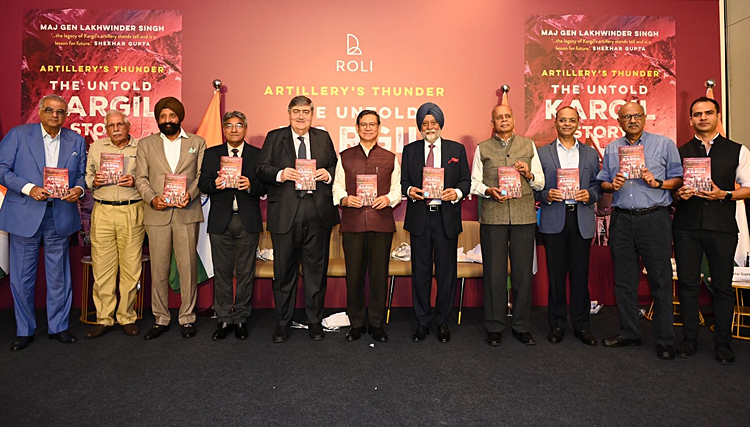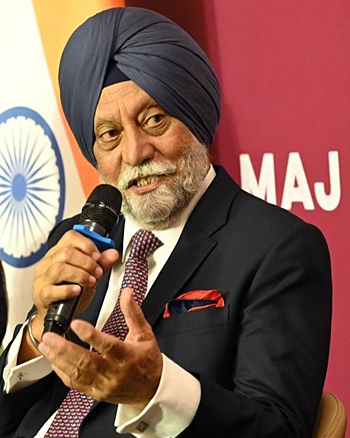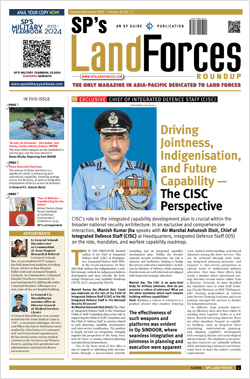INDIAN ARMED FORCES CHIEFS ON OUR RELENTLESS AND FOCUSED PUBLISHING EFFORTS

The insightful articles, inspiring narrations and analytical perspectives presented by the Editorial Team, establish an alluring connect with the reader. My compliments and best wishes to SP Guide Publications.

"Over the past 60 years, the growth of SP Guide Publications has mirrored the rising stature of Indian Navy. Its well-researched and informative magazines on Defence and Aerospace sector have served to shape an educated opinion of our military personnel, policy makers and the public alike. I wish SP's Publication team continued success, fair winds and following seas in all future endeavour!"

Since, its inception in 1964, SP Guide Publications has consistently demonstrated commitment to high-quality journalism in the aerospace and defence sectors, earning a well-deserved reputation as Asia's largest media house in this domain. I wish SP Guide Publications continued success in its pursuit of excellence.
- All about HAMMER Smart Precision Guided Weapon in India — “BEL-Safran Collaboration”
- US to sell $93 million precision artillery, Javelin and Excalibur projectiles to India
- US to sell $93 million precision artillery, Javelin and Excalibur projectiles to India
- India, Germany deepen defence ties as High Defence Committee charts ambitious plan
- True strategic autonomy will come only when our code is as indigenous as our hardware: Rajnath Singh
- India-Israel Joint Working Group Meeting on defence cooperation to boost technology sharing and co-development
- G20 Summit: A Sign of Global Fracture
When the Guns Spoke: Artillery's Thunder: The Untold Kargil Story
Major General Lakhwinder Singh (Retd) recounts how 108 guns and 2.9 lakh rounds broke enemy defences in Dras – and why India must invest in precision artillery for future wars.

Artillery's Thunder: The Untold Kargil Story, authored by Major General Lakhwinder Singh (Retd), was officially released in New Delhi before an audience of Kargil War veterans, senior military leaders, government officials, defence scholars, members of the judiciary, and journalists.
The evening featured a panel discussion moderated by senior defence journalists. The discussion examined the strategic setting of the 1999 Kargil War – including the Pakistani military's objectives, India's intelligence assessments following the Lahore Bus Yatra, and the decisive role of artillery in turning the tide of battle.
Insights from the Author

Sharing his first-hand experience from Dras, Major General Singh recalled how 108 guns were brought into action at Tololing, delivering a decisive barrage that shifted the momentum of the conflict.
"Without Artillery, Infantry soldiers would not have been able to climb the hills," said Major General Singh, underscoring the life-saving importance of gunnery support in high-altitude combat.
He estimated that nearly 290,000 artillery rounds were fired during Operation Vijay – among the most intense artillery bombardments since World War II – drastically reducing infantry casualties and compressing the duration of the war.
"The guns broke the resistance of Pakistani Army on the high-altitude posts established by them," he added, noting that artillery fire shook enemy morale to the point that Indian infantry soldiers would salute the guns after returning from the battlefield.
Strategic Takeaways
Panelists connected lessons from Kargil to contemporary conflicts, including the Russia–Ukraine war, calling for greater investment in precision artillery and massed-fire capability to deter future aggression.
Justice Sanjay Kishan Kaul (Retd) praised Major General Singh for having "orchestrated a symphony of steel fire" in Dras and called the book "unputdownable." Justice N. Kotiswar Singh drew parallels with 1947, when Indian forces first brought armour into Kargil. Former Defence Secretary Dr. Ajay Kumar emphasised India's growing indigenous artillery capabilities and called the book a tribute to the gunners' spirit of gallantry.
About the Book
Artillery's Thunder is a first-hand account of the decisive role played by Indian Artillery during Operation Vijay. From the Bofors FH77B howitzers pounding enemy positions to innovative direct-fire tactics that broke the deadlock at Tololing and Tiger Hill, the memoir captures the intensity of one of India's most challenging high-altitude battles.
Major General Lakhwinder Singh (Retd), awarded the Yudh Seva Medal and famously called the "Enraged Bull of Dras" for his leadership, provides rare insights into how massed artillery fire changed the course of the Kargil War.
Blending battlefield narrative with strategic foresight, the book draws connections between the lessons of 1999 and present-day challenges, including the 2025 Pahalgam attack and Operation Sindoor. It makes a compelling argument for sustained investment in precision artillery systems and modernization of India's firepower to meet future threats.





